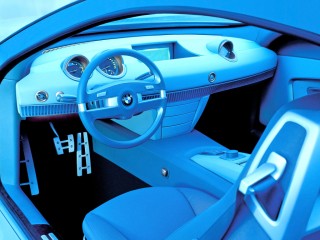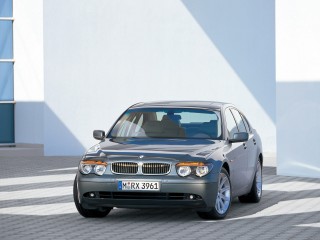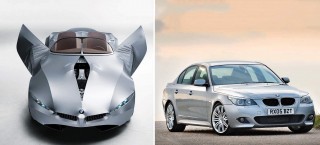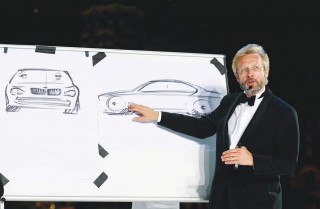Chris Bangle was born in Ohio, attended the University of Wisconsin and then the prestigious Art Centre College of Design, in Pasadena. He joined BMW in 1992 after spells with Opel and Fiat.
If one had taken the trouble to type ‘Chris Bangle’ into a search engine in the early noughties, one of the first results to pop up would have been an online petition started by dyed-in-the-wool BMW fans who were desperate for BMW to sack Chris Bangle.
To those enthusiasts’ eyes, he was the devil incarnate, and the man responsible for ruining BMW; the man who, in a few short years, had taken the classically-styled BMW design language and turned it on its head.
It’s fair to say that in some quarters he wasn’t popular. But was the vitriol directed at Bangle really deserved? Wasn’t it about time someone shook up BMW’s design department?
BACK FROM THE BRINK
BMW’s expansion during the 1970s and 1980s was nothing short of phenomenal, for a company that had been teetering on the brink of oblivion in the late 1950s and early 1960s. The ’02 model range had a total production volume of just over 850,000 in an 11-year run but, just two generations on from that, the E30 3 Series almost tripled that figure, with over 2.3 million examples being produced. It was a similar story with the ‘Neue Klasse’ saloon, with 350,000 examples being produced – a figure that was doubled by the E12 5 Series that replaced it, and nearly doubled again, to 1.3 million, with the E34 5 Series.

While it seemed that BMW could virtually do no wrong, there was a distinct feeling that its designs, while attractive and inoffensive, were a little bit on the ‘safe’ side. Machinery such as the E34 5 Series and the E32 7 Series, embodied all the classic, BMW styling cues but, when the E38 Seven came along in 1994, it was criticised in some sections of the media for being rather too safe a design. Ironic, really, that BMW’s bad boy Bangle had already been at the helm for two years by the time the E38 made its debut.
BANGLE BACKGROUND
So, who was the man who revolutionised BMW’s design department? Chris Bangle was born in Ravenna, Ohio, (making him the first American to oversee BMW design) in October 1956. He was educated at Wausau West High School, Wisconsin, the University of Wisconsin, and the prestigious Art Centre College of Design, in Pasadena, before he joined BMW in October 1992.
A sign of things to come; the Z9 Concept that was unveiled at the Frankfurt Motor Show in 1999.
Left: The interior of the Z9 Concept shocked many, with its almost complete lack of conventional switchgear, and central iDrive screen.

Before that appointment, he’d been Deputy Head of Interior Design with Opel in the early 1980s, then Head of Exterior Design at Fiat and, latterly, Director of Fiat Centro Stile, where he created the Fiat Coupé, itself a somewhat unconventional machine that should have set alarm bells ringing in BMW enthusiast’s ears. He’s also (incorrectly) sometimes attributed as the Fiat Multipla’s designer and, while this isn’t the case, the man responsible for that gawky, people-carrier worked at Fiat under Bangle, and was no doubt influenced by his unconventional approach.
And that’s perhaps one of the ironies of Bangle’s time at BMW; he wasn’t actually responsible for the precise design of any individual BMW models. Certainly, he was BMW’s Head of Design for eight years, before being promoted to Head of BMW Group Design, in 2004 and, while some thought this latter position would see him taking less of a leading role, that couldn’t have been further from the truth.
While his name may have become synonymous with the bootlid treatment (the ‘Bangle butt’) of some of the models produced under his watch, it was his influence on the design team rather than his penmanship, that resulted in many of the cars known from the Bangle era.
EARLY INFLUENCE
Such is the development cycle of modern cars – designs are signed-off way before we even start to see camouflaged mules doing the testing rounds – that the first cars to emerge from Munich after Bangle took over in 1992, had more or less nothing to do with him. The E38 Seven’s look had been set in stone by the time he arrived, and Joji Nagashima’s design for the E39 5 Series had been chosen by the BMW board in mid-1992, again prior to Bangle’s arrival, although he may have had a little to say on the fine-tuning of the Five’s look.
It would have been a big risk for the board to have sanctioned something more outlandish
It was a similar story with the retro-styled Z3 (again, penned by Nagashima). The first machine he could conceivably have been seriously involved with from the outset was the E46 3 Series… but isn’t that car now revered as one of BMW’s great pieces of design?

The E46’s shape was actually penned by Erik Goplen when he was working at BMW’s subsidiary Designworks, in California, and the car’s shape was signedoff by Chris Bangle who worked closely on its design with Goplen. In comparison to some of Bangle’s BMWs, it’s a remarkably staid-looking piece of design, but incorporates all of the classic BMW design cues, such as the quad lamps, kidney grilles and the Hofmeister kink.
The E65 7 Series was a controversial car that certainly divides opinion. Quite apart from anything else, many consider that it wears a sad face.
So why didn’t the E46 Three get the first Bangle treatment? Well, speaking to BMW Car 10 years ago, Bangle was remarkably candid on the subject: “The 3 Series is an icon, and with all icons you have to be a little bit careful not to stray off,” he said. At the time, the 3 Series was responsible for the vast majority of sales, so it would have been a big risk for the board to have sanctioned something more outlandish, and perhaps the same could have been said of the original X5, that was also penned during Bangle’s watch.
PLAYING IT SAFE
At the time, BMW had no idea whether the X5 concept was going to be a success so, again, it’s perhaps unsurprising that for this entirely new segment the company didn’t opt for anything too outlandish. The final design was penned by Chris Chapman, who had joined BMW Group’s Designworks in California, and later began working with Bangle in Munich on the E53. While the relatively conventionally-styled X5 made its debut in 1999, it was another BMW that really got the tongues wagging at the 1999 Frankfurt Motor Show – the distinctive Z9 Concept.

It’s Bangle who is credited by many for the design but, in fact, it was one of his protégés, Adrian van Hooydonk (now head of BMW Group Design) who was responsible. Of course, as the years have passed, the look of the Z9 Concept has paled somewhat; it’s no longer quite as outrageous as it appeared at its unveiling 18 years ago. Nevertheless, it’s still hard to believe that it arrived just a couple of years after the E39 Five and the E46 3 Series, or even that it was the product of the same manufacturer.
Left: One of Bangle’s most extreme designs was the GINA; a fabricskinned, shape-shifting concept car. Below: The majority of the Bangleinfluenced designs – including this E60 5 Series – look pretty good, especially in M Sport guise.
It looked massive and had some very un-BMW-esque detailing, such as the huge bootlid that sat on top of the rear wings, the enormous doors and the odd eyebrow indicators sitting over the headlights. Inside there was the first interpretation of iDrive to behold, plus a dash that was almost entirely devoid of switchgear. It was a shock to everyone’s BMW system, but at least it was only a concept…
SLAB SIDES AND EYEBROWS
Well, that’s what everyone thought, until the E65 7 Series made its debut in 2001. Many of its design cues were plucked from the Z9 – the boot lid, the slab sides that were almost devoid of detailing, and those headlight eyebrows all made it to production, as did the infamous first take on the iDrive system. It was a shock to the system – it was neither elegant or tasteful, and had a lugubrious, sad face about it and it’s fair to say that the majority of observers simply couldn’t get their heads around it.
It was a shock to the system – it was neither elegant or tasteful, and had a lugubrious, sad face
Once again, though, it was another van Hooydonk design and, when his E63 6 Series saw the light of day in 2003, the ties to the Z9 Concept made more sense. The production car was a toned-down version of the show car, which utilised most of the Z9’s design cues, apart from the gullwing doors.
There were more shocks on the horizon – the Z4 Roadster created a stir for being the car to which Bangle attributed his ‘flame surfacing’ design language. David Arcangeli’s E60 5 Series was a real shock to the system, following the svelte and rounded E34 and E39 Fives, while the first X3 was an ungainly-looking machine when contrasted with its X5 brother.
But perhaps the one model in the range that didn’t go for the full, extreme Bangle look was the E90 generation of 3 Series; maybe the board decided to play it safe with the mainstay of the range. By way of contrast, the original 1 Series – penned by Brit Kevin Rice under Bangle’s watchful eye – had a more unconventional look, and this may have been to distinguish the car from the increasingly homogenous hatchback design that was around at the time. The BMW had its rear-wheel drive USP, so it might as well look unique too.
FLEXIBLE DESIGN
Perhaps one of Bangle’s most extreme machines was the GINA, where the design team’s imagination was allowed to run riot. It had a body of seamless fabric, made from polyurethane-coated Lycra stretched over a moveable metal frame, which allowed the driver to change the car’s shape at will, only seeing the items that were required for the moment.
Bangle said that GINA allowed his team to “challenge existing principles and conventional processes,” and BMW added that, “It is in the nature of such visions that they do not necessarily claim to be suitable for series production,” when the car was revealed.
But to hear Bangle describing the design process behind this – or any other that was produced under his watch – was a fascinating experience. He infused his audience with a passion and an understanding for what he was doing. So much so that, by the end of any given speech, the audience was left wondering why every car company wasn’t doing things this way!
When we previously spoke to him about his design direction, I remember asking about his objectives at BMW; “One of the characteristics of BMW is a tradition of forward-looking change, while still respecting our heritage,” he replied. “Traditionally at BMW, there has always been a spirit of moving forward without ignoring your roots. Heritage at BMW is not only keeping up with icons – the straight-six- cylinder engines, the classic rear-wheel drive set-up or the double kidney grille. The other half of the heritage is the obligation to move ahead and push the envelope, in techniques as well as in the way these techniques are seen.”
It was clear that he didn’t want to create anything dull, and we spoke about whether it was possible to be creative without being provocative, or to create anything genuinely exciting without pushing close to the edge? “Yes, sure, it’s possible. You can create exciting things that nobody notices.
If there’s no ‘depth’ in the design, it risks being rather unsophisticated.
“Anything with depth opens itself to many interpretations, but provocation per se would be on our wish list. We work in cycles of approximately seven years for every model, and we want to offer something that provides excitement over this whole period of time, across a world of diverse customers.
“Take the [E63] 6 Series. There are plenty of people whose discussions were provoked by the design of the original concept Z9 GT, shown in 1999. Now the 6 Series is in production four years later, and it’s a great car with a design that’s still essentially the Z9.”
GONE TOO SOON?
When Bangle’s era came to a relatively abrupt end with his resignation in 2009, one could also say that it was too soon; that he hadn’t seen the BMW project through to its logical conclusion. However, with van Hooydonk – a Bangle protégé at the helm – it’s almost as if his work is continuing.

During his time at BMW, Bangle was the design figurehead and was the one who took the flak for what critics didn’t like. But he was always keen to emphasise he was just part of a team, albeit one who was incredibly adept at motivating and challenging his designers.
To those enthusiasts’ eyes, he was the devil incarnate, and the man responsible for ruining BMW
“I’d say it’s all about passion,” he commented when we interviewed him. ‘‘I’m leading a team of passionate people who are part of an even larger team of equally passionate people, and who all have one common goal – creating fascinating cars and motorcycles.
Listening to Chris Bangle describe his design was a fascinating and inspiring experience.
“My team’s task is to give a visible form to this emotion – showing that what motivated engineers and craftsmen create, is more than just an intelligent assembly of parts. It’s like showing the soul of a machine. And I’m happy to be kind of a coach and manager of this great team.”
Now that the internet petitions to sack him are but a distant memory, how have Bangle’s era of designs fared? Beauty is in the eye of the beholder and all that, but I’d go so far as to say that the majority of them look pretty good, especially in M Sport guise. The original Z4 and E63 6 Series, in particular, still survive rather well, I reckon.





